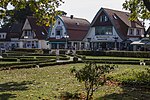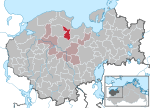Klütz
Cities and towns in MecklenburgNordwestmecklenburgNordwestmecklenburg geography stubsPages with German IPAPopulated places established in 1938 ... and 1 more
Towns in Mecklenburg-Western Pomerania

Klütz (German pronunciation: [ˈklʏts]) is a town in the Nordwestmecklenburg district, in Mecklenburg-Western Pomerania, Germany. It is situated near the Baltic Sea coast, 22 km northwest of Wismar, and 33 km northeast of Lübeck. It is famous for the manor house Bothmer Castle, located just outside the village. In the centre of the village lies the medieval Brick Gothic village church, dedicated to Our Lady. There is also a centre of literature named after writer Uwe Johnson in the town. It is close to the cities of Lübeck, Wismar and Schwerin and is part of the Hamburg Metropolitan Region.
Excerpt from the Wikipedia article Klütz (License: CC BY-SA 3.0, Authors, Images).Klütz
Schulweg, Klützer Winkel
Geographical coordinates (GPS) Address Nearby Places Show on map
Geographical coordinates (GPS)
| Latitude | Longitude |
|---|---|
| N 53.966666666667 ° | E 11.166666666667 ° |
Address
Schulweg 5
23948 Klützer Winkel
Mecklenburg-Vorpommern, Germany
Open on Google Maps







